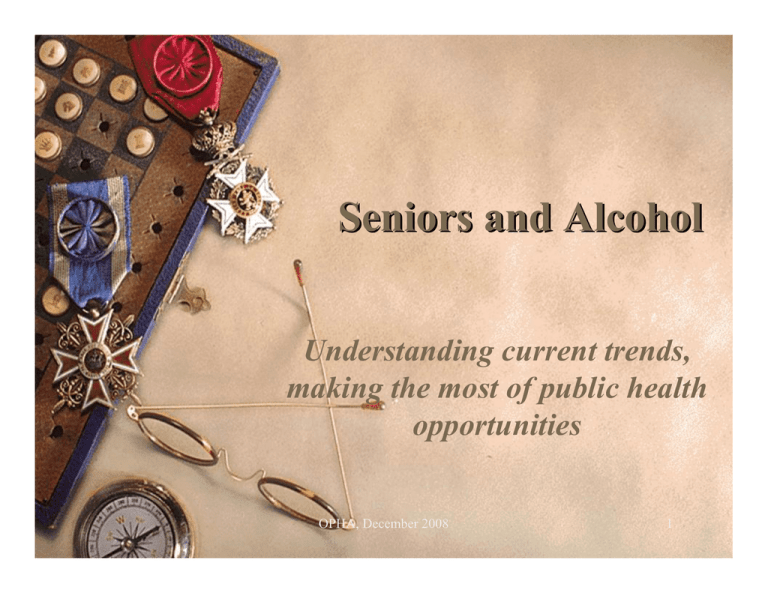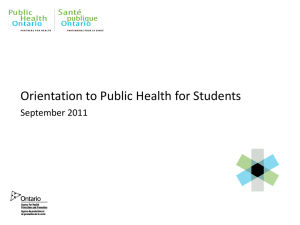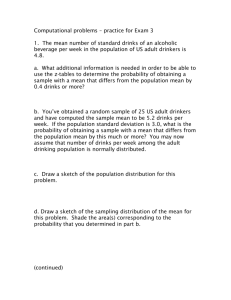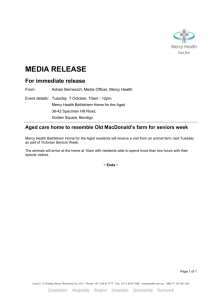Seniors and Alcohol Understanding current trends, making the most of public health opportunities
advertisement

Seniors and Alcohol Understanding current trends, making the most of public health opportunities OPHA, December 2008 1 Presented by Charmaine Spencer, Gerontology Research Centre & Project S.E.A.G.U.L.L. (Seniors and Alcohol: Guidelines for Use in Later Life) Project SEAGULL was made possible through a contribution from the Public Health Agency of Canada. OPHA, December 2008 2 Dramatic Demographic Change in Canada Or “Where did all the young people go?” – Median age of Canadian population was 27.2 years in 1956. Now its 39.5 years. – People aged 65+ increased from 7.7% of total pop in 1956 to 13.7% in 2006 – Depending on province, % of seniors will range 19 to 27% of pop by 2026 – % of people aged <15 years have decreased from 32.5% in 1956 to 17.7% in 2006 Source: Statistics Canada, censuses of population, 1956 to 2006. OPHA, December 2008 3 Starting Points- Seniors Who are we talking about? “Young-old” Aged 65-74, healthier, and more comparable to other middle aged “Old-old” Aged 75 +; some health changes, chronic conditions; more women Those aged 85+ Mainly women; chronic health conditions much more common; 1/3 of the age group may have some cognitive impairment OPHA, December 2008 4 Basic Figures In 2004 over three quarters (77%) of adults in Canada aged 65 to 74 consumed alcohol in the past year, as did about two thirds of adults aged 75 and over. There has been a 42% increase from 1989 to 2004 in the number of occasional or regular older drinkers; – Reflect demographic shift + greater percentage of older adults drinking – Largest population shift in consumption ever seen OPHA, December 2008 5 Emerging Trends: Alcohol Use Reduction in the gender gap Drinking among 75+ year olds is increasingly commonplace – (2/3rds consume); fewer lifetime abstainers Low level drinking is common, but 15% drinking at risk quantity wise OPHA, December 2008 6 Canada: More Seniors now Regular Drinkers ¾ 1 in 5 (20.6%) aged 65+ are consuming alcohol on 4+ days a week; ¾ 1 in 4 (24.2%) aged 75+ drink 4+ days a week ¾ Another one quarter are drinking 1-3 days a week Source: CAS Table, Table 3.2 OPHA, December 2008 7 Overall Percentages Can Hide Important Trends Multiple trajectories for older adults: abstainers, stable drinking, declining drinking, and curvilinear At transitions (unemployment, retirement, health changes) – percentage decreasing + percentage increasing consumption may yield an apparent net zero change OPHA, December 2008 8 Older Adults’ Views of Moderation In 2001 US study of Public health educators over 900 middle aged consider "moderate and older adults, drinking" as 1 drink – 1 in 5 (19%) of for women, 2 for men. adults aged 50-59 considered drinking 3-4 drinks/day as “moderate”; – So did 1 in 7 (15%) adults aged 60-87 Source: AARP, 2001 OPHA, December 2008 9 The Good News… In general moderation continues Over 85% of drinkers aged 65 years or older drink “moderately” (1-2 drinks on a typical drinking day). Rest are above. Which part of the glass do we focus on? OPHA, December 2008 10 Risks for Older Adults Quantity is only one measure Physiological changes with age Circumstances of use Polypharmacy OPHA, December 2008 11 A Special Risk for Older Adults 2003 Canada Community Health Survey Over 9 in 10 seniors in the community took at least one type of medication during the month prior to the survey. On average, seniors used three different types of medication. (5-6 medications commonplace) ~~ >150 medications commonly prescribed to older adults interact with alcohol. Wide ranging risks. OPHA, December 2008 12 Classes of Prescription Medications that can Interact with Alcohol antibiotics, antidepressants, antihistamines, benzodiazepines, histamine H2 receptor antagonists, muscle relaxants, non-narcotic pain medications and antiinflammatory agents, opioids, and warfarin. Source: Weathermoon & Crabb, 1999 OPHA, December 2008 13 Most Commonly Medications used by Seniors Non-narcotic pain relievers Blood pressure medication Heart medication Diuretics Stomach remedies. Source: M. Rotterman (Statistics Canada), 2006. OPHA, December 2008 14 What We Know about Seniors who Drink and Take Medications The most commonly used high-risk drugs for drinkers are – antihypertensives (drugs to lower high blood pressure), – aspirin and nonsteroidal anti-inflammatory drugs. The drugs with the highest risk for drinkers may be those for pain relief or anxiety. Must address the pain or underlying condition though. OPHA, December 2008 15 Examples of Alcohol/Medication Interactions Source : National Consumer League Alcohol Interaction Harm reduction? NSAIDs Liver damage, stomach bleeding (hemorrhage, perforation); effect multiplicative, 3 drinks+ day. Risk within therapeutic use Reduce alcohol; buffered medications, timing of alcohol use? Reduction of the amount of pain reliever? Adjunctive therapy? Statins (cholesterol lowering drugs) Increased risk of liver damage Avoid large amounts of alcohol High blood pressure medications, beta blockers, nitrates Can lower blood pressure General education? too much – falls risk Understanding the connection OPHA, December 2008 16 Risk of Interactions 38% of senior drinkers report use alcohol and a high-risk medication in the previous 6 months High risk medications used by 85% of those who consumed one to six drinks per week and 80% of those who consumed seven or more drinks weekly (Adams, 1995) Need to separate single use risks from repeated use risks OPHA, December 2008 17 Risks for older adults depend on Quantity Health conditions Medications including Chronicity over the counter drugs Timing of consumption OPHA, December 2008 18 Who is most at risk ? Studies on co-occurring exposure to alcohol and alcohol interactive drugs vary somewhat. Pringle et al, 2005 says: younger seniors, men, and seniors with higher education OPHA, December 2008 19 Prevention in Later Life OPHA, December 2008 20 The Need for Prevention One third of problem use among older adults develops in later life Even among people with early onset problems, new issues (and prevention opportunities) will arise OPHA, December 2008 21 Two levels of prevention information needs For service providers: – To create a better understanding of • role of alcohol or other drugs in later life within the underlying determinants of health (e.g. income, health, supportive networks, biology, education) • key concepts of healthy aging and what being healthy means to older adults • diversity in aging • when alcohol or other drug use may become a negative outcome in later life OPHA, December 2008 22 Two levels of prevention information needs For seniors: – To create information and supports at the individual level to aid individual behaviour change. – Better understanding of risks and benefits (general audience) – Alternatives to help reduce risks OPHA, December 2008 23 We need to remember older adults Have a lifetime of decisionmaking experience Are capable of evaluating relative risks and benefits of moderate alcohol use when provide adequate information AND viable alternatives OPHA, December 2008 24 Common Mistaken Beliefs & Attitudes There is no harm. The harm has already been done. Older people are unable to make changes. Seniors have limited potential That use/misuse is only based on individual choices. OPHA, December 2008 25 Prevention Challenges Key persons often least likely to recognize the problem/issue Lack of message consistency for public – Complexity of the alcohol/ health message Low health literacy; low media literacy Sources of endemic gentle persuasion OPHA, December 2008 26 Who is or is not Doing “Prevention”? Great opportunities but relatively low priority to health promotion Few provinces mention alcohol in their health promotion strategies Media focus on potential substance misuse, abuse or dependency is youth focussed Plus: Stereotypes, Ageism, Stigma OPHA, December 2008 27 The SODDI defense in prevention “Some other dude is doing it” (e.g. alcohol treatment services). But they typically aren’t. Prevention work for middle aged and older adults still uncommon in public health, acute care, pharmacy, addictions, or mental health. OPHA, December 2008 28 Reaching At Risk Seniors Alcohol & Health – What really causes good health in later life – Absence of disease is not the same as being healthy Alcohol & Chronic Pain Alcohol & Sleep Alcohol & High Risk Medications Alcohol, Chronic Disease and Depression The message is awareness and harm reduction OPHA, December 2008 29 Messages that make sense Understanding the range of circumstances for older adults use- social, health change and health management, loneliness, habit Opportunities in injury prevention OPHA, December 2008 30 Like a good golf score, keep it low. low More than 2 standard drinks a day significantly increases your risk of health problems … including high blood pressure, stroke and cancer. Know the Hidden Hazards OPHA, December 2008 31 Special Notes Alcohol and Health Paradox Levels of drinking promoted to reduce CHD are the same dose levels at which risk of other important diseases increases – Especially for older adults – E.g. breast cancer risk at age 80 is 1 in 11, each additional drink increases the risk Understanding reasons for use of alcohol by those with chronic conditions Understand the limitations of the research OPHA, December 2008 32 Special Notes Important limitations of the epidemiological information on moderate alcohol use and health in later life – may include socio-economic characteristics, – but typically fails to take income into account • or it uses broad non-discriminative income categories Also typically fails to take social determinants underlying specific disease risk, CHD into account OPHA, December 2008 33 Mental Health 65+ risk factors Loss of a partner Social isolation Reduced social support Protective factors Stable supportive relationships OPHA, December 2008 34 Common and Emerging Mental Health Issues in Later Life Anxiety affects 1 in 10 older adults – feeling anxious most of the time to the point that it is interfering with sleep or normal functioning. Depression – 15-20 % of older persons, experience clinical levels of depression, more common among those with chronic diseases, especially those conditions causing pain, disrupting sleep OPHA, December 2008 35 Promising Opportunities OPHA, December 2008 36 3 Possible Strategies 1. Alcohol focus only- with age relevant information 2. Integrate into other prevention opportunities relevant to older adults: falls/ injury prevention, driving, sleep, pain control, mental health ……Both strategies needed 3. Information tailored to the individual OPHA, December 2008 37 The Risk of Vague Messages What we are telling them, vs. what they want to hear – Generic information – Avoid alcohol, “certain medications” – Not sufficiently clear so that they can make informed decisions – How does this apply to me and what are the alternatives OPHA, December 2008 38 Youth’s alcohol caution, is older adults’ alcohol promotion? Avoiding ambiguity and potentially harmful messages for older persons OPHA, December 2008 39 Message Consistency & Low Risk Drinking Guidelines In 1998, Walsh, Bondy & Rehm identified 18 guidelines in use in Canada Today, still a variety of guidelines in use – Ontario (CAM-H) 2 per day; weekly 9 for women, 14 for men, mentions avoid if have liver disease, cancer mental health problems, medications – British Columbia (CARBC): daily limit: 4 drinks for men, 3 for women; weekly limit 20 for men, 10 for women; 1-2 days a week drink free; mentions avoid if physical or mental health problems. OPHA, December 2008 40 How does the public including older adults interpret the inconsistency? OPHA, December 2008 41 Public Health Opportunities and Recommendations Need for development and promotion of national low risk drinking guidelines that can apply to all ages, – recognize different populations face different risks OPHA, December 2008 42 Public Health Opportunities and Recommendations Think seniors! – Alcohol- medications in the context of injury prevention and mental wellbeing can be useful starting points for public health education for older adults (e.g. confusion, falls, hospitalization, driving) OPHA, December 2008 43 Thank you OPHA, December 2008 44 References Adams, W. (Sept 1995). Potential for adverse drugalcohol interactions among retirement community residents. Journal of the American Geriatrics Society, 43 (9), 1021-1025. AARP, 2001 Breslow, R.A. (2004). Drinking patterns of older Americans: National Health Interview Surveys, 19972001. Journal of Studies on Alcohol, 65 (2), 232-240. Canadian Addiction Survey CAMH Low Risk Drinking Guidelines. Centre for Addiction Research BC Low Risk Drinking Guidelines. OPHA, December 2008 45 References National Consumer League. Food and Drug Interactions. Online : http://www.nclnet.org/Food%20&%20Drug.pdf Onder, G., Landi, F., Vedova, C.S., Atkinson, H., et al. (2002). Moderate alcohol consumption and adverse drug reactions among older adults. Pharmacology and Drug Safety, 11(5), 385-392. Pringle, K.E., Ahern, F.M., Heller, D.A., Gold, C.H. et al. (Nov. 2005). Potential for alcohol and prescription drug interactions in older people. Journal of the American Geriatrics Society, 53 (11). 1930-1936. Walsh G.W., Bondy, S.J, & Rehm, J. (1998) Review of Canadian low-risk drinking guidelines and their effectiveness. Can J Public Health. Jul-Aug, 89(4),241-7. Weathermon, R. & Crabb, D. W. (1999). Alcohol and medication interactions. Alcohol Health and Research World, 23 (1), 40-54. http://pubs.niaaa.nih.gov/publications/arh23-1/40-54.pdf OPHA, December 2008 46




